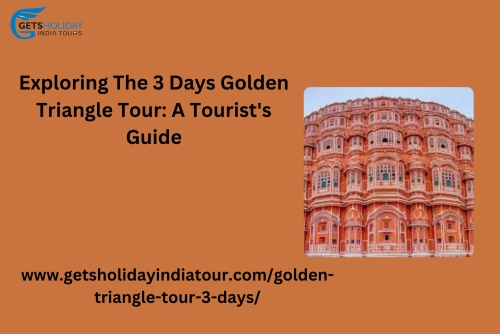India is a land of rich cultural heritage, fascinating history, and breathtaking landscapes. Among its countless destinations, the Golden Triangle Tour stands out as one of the most popular tourist circuits. Covering the iconic cities of Delhi, Agra, and Jaipur, this tour offers a glimpse into India's royal past, architectural marvels, and vibrant traditions. If you’re pressed for time, a 3 Days Golden Triangle Tour can provide an unforgettable experience.
In this guide, we’ll walk you through everything you need to know to make the most of your Golden Triangle tour in three days.
Why Choose the 3 Days Golden Triangle Tour?The Golden Triangle refers to the geographical arrangement of Delhi, Agra, and Jaipur, which form a triangular shape on the map of northern India. Each city is about 200–250 km from the others, making it possible to visit the key landmarks of all three within a short span of time.
A 3 Days Golden Triangle Tour is ideal for travelers who want to:
Experience the best of Indian history and culture in a short duration.
Visit UNESCO World Heritage sites like the Taj Mahal, Agra Fort, and Qutub Minar.
Explore the royal palaces of Jaipur, also known as the Pink City.
Take a deep dive into India's architectural brilliance, with styles ranging from Mughal to Rajputana.
Day 1: Delhi - The Capital CityMorning: Arrival in Delhi & City ExplorationYour Golden Triangle Tour begins in Delhi, the bustling capital city that offers a blend of ancient and modern attractions. Start your day early and head to explore Old Delhi, where you'll find landmarks that reflect India's rich Mughal history.
Red Fort – A UNESCO World Heritage Site, this red sandstone fort served as the residence of Mughal emperors. Its impressive architecture and grandeur will leave you in awe.
Jama Masjid – One of the largest mosques in India, Jama Masjid offers breathtaking views of Old Delhi from its towering minarets.
Afternoon: New Delhi LandmarksAfter exploring the charm of Old Delhi, it's time to move to New Delhi, the modern and well-planned part of the city. You can visit:
India Gate – A war memorial built in honor of Indian soldiers who fought in World War I. The India Gate is a great place for a leisurely stroll.
Rashtrapati Bhavan – The official residence of the President of India, Rashtrapati Bhavan is an architectural masterpiece. Though entry is restricted, you can view it from outside.
Qutub Minar – Another UNESCO World Heritage Site, this towering minaret is one of the finest examples of Indo-Islamic architecture.
Evening: Drive to Agra (Approx. 4 hours)In the evening, start your drive to Agra, the second city of the Golden Triangle. Upon arrival, check into your hotel and relax, preparing for the next day’s adventure. You can also take a night view of the Taj Mahal, as it looks stunning under the moonlight.
Day 2: Agra - The City of the Taj MahalMorning: Visit the Taj MahalBegin your day with a sunrise visit to the Taj Mahal, one of the Seven Wonders of the World. The morning light casts a magical glow on this white marble mausoleum, making it one of the best times to visit. Commissioned by Shah Jahan in memory of his beloved wife Mumtaz Mahal, the Taj Mahal is a symbol of eternal love and an architectural marvel.
Spend time admiring its intricate details, the gardens, and the reflecting pools. Make sure to capture photos from various angles to fully appreciate its beauty.
Mid-Morning: Agra FortJust a few kilometers from the Taj Mahal lies the Agra Fort, a UNESCO World Heritage Site and another architectural masterpiece from the Mughal era. Built by Emperor Akbar, this fort is a walled city with palaces, halls, and gardens. The Diwan-i-Khas and Diwan-i-Aam are must-visit halls within the fort.
Afternoon: Drive to Jaipur (Approx. 5 hours)Post lunch, it's time to hit the road and head to Jaipur, the third city in your Golden Triangle Tour. En route, you can stop at Fatehpur Sikri, a historical city founded by Emperor Akbar. The city’s architectural grandeur and fascinating history make it a great stop for history enthusiasts.
Upon reaching Jaipur, check into your hotel for a comfortable night’s stay.
Day 3: Jaipur - The Pink CityMorning: Explore Jaipur's Royal HeritageStart your day in Jaipur, famously known as the Pink City due to the pink hue of its buildings. Jaipur is renowned for its palaces, forts, and vibrant bazaars. Begin your exploration with a visit to:
Amber Fort – Located on a hill, the Amber Fort is a majestic palace with intricate designs, sprawling courtyards, and a stunning view of the surrounding landscape. You can either walk up to the fort or take an elephant ride, which is a unique experience.
Hawa Mahal – Also known as the Palace of Winds, this stunning five-story palace features hundreds of small windows that allowed royal women to observe street life without being seen.
Afternoon: City Palace & Jantar MantarAfter visiting the Amber Fort, head back to the city center to explore the City Palace, the residence of Jaipur’s royal family. The palace complex includes beautiful courtyards, gardens, and museums that display royal costumes and artifacts.
Just a short walk from the City Palace is the Jantar Mantar, an astronomical observatory and a UNESCO World Heritage Site. Built in the 18th century, it houses architectural instruments that were used to study the movements of celestial bodies.
Evening: Drive Back to Delhi (Approx. 5 hours)As your Golden Triangle Tour comes to an end, bid farewell to Jaipur and drive back to Delhi. You can either head to the airport for your flight home or spend the night in Delhi before continuing your travels.
ConclusionThe 3 Days Golden Triangle Tour is a perfect blend of history, culture, and architecture. Despite the short duration, this tour offers an enriching experience of India's Mughal and Rajput heritage, while also providing a glimpse into the modern aspects of Delhi. Whether you’re a history buff, a photographer, or a traveler seeking to explore India’s iconic landmarks, the Golden Triangle Tour will leave you with unforgettable memories.












